How to quickly pass the Microsoft DP-300 exam 2021? Microsoft DP-300 dumps provides a simple and smart way to pass the challenging DP-300 exam in a short time. In terms of the best platform for Microsoft DP-300 dumps, I think https://www.pass4itsure.com/dp-300.html is the right choice.
Study and Share Most up-to-date Updates Microsoft DP-300 Dumps Question
Microsoft DP-300 Dumps PDF Download
Free Microsoft DP-300 pdf https://drive.google.com/file/d/1XXQ2AhHiEEU9GDPPyXO8fT_0VOjtuG1I/view?usp=sharing
Microsoft DP-300 Practice Test 1-13 Free
QUESTION 1
You are planning disaster recovery for the failover group of an Azure SQL Database managed instance.
Your company\\’s SLA requires that the database in the failover group become available as quickly as possible if a
major outage occurs.
You set the Read/Write failover policy to Automatic.
What are two results of the configuration? Each correct answer presents a complete solution.
NOTE: Each correct selection is worth one point.
A. In the event of a datacenter or Azure regional outage, the databases will fail over automatically.
B. In the event of an outage, the databases in the primary instance will fail over immediately.
C. In the event of an outage, you can selectively fail over individual databases.
D. In the event of an outage, you can set a different grace period to fail over each database.
E. In the event of an outage, the minimum delay for the databases to fail over in the primary instance will be one hour.
Correct Answer: AE
A: Auto-failover groups allow you to manage replication and failover of a group of databases on a server or all
databases in a managed instance to another region.
E: Because verification of the scale of the outage and how quickly it can be mitigated involves human actions by the
operations team, the grace period cannot be set below one hour. This limitation applies to all databases in the failover
group regardless of their data synchronization state.
Incorrect Answers:
C: individual SQL Managed Instance databases cannot be added to or removed from a failover group.
Reference: https://docs.microsoft.com/en-us/azure/azure-sql/database/auto-failover-group-overview
QUESTION 2
You have an Azure SQL database named sqldb1.
You need to minimize the amount of space by the data and log files of sqldb1.
What should you run?
A. DBCC SHRINKDATABASE
B. sp_clean_db_free_space
C. sp_clean_db_file_free_space
D. DBCC SHRINKFILE
Correct Answer: A
DBCC SHRINKDATABASE shrinks the size of the data and log files in the specified database. Incorrect Answers:
D: To shrink one data or log file at a time for a specific database, execute the DBCC SHRINKFILE command.
Reference: https://docs.microsoft.com/en-us/sql/t-sql/database-console-commands/dbcc-shrinkdatabase-transact-sql
QUESTION 3
DRAG DROP
You have a resource group named App1Dev that contains an Azure SQL Database server named DevServer1.
DevServer1 contains an Azure SQL database named DB1. The schema and permissions for DB1 are saved in a
Microsoft SQL
Server Data Tools (SSDT) database project.
You need to populate a new resource group named App1Test with the DB1 database and an Azure SQL Server named
TestServer1. The resources in App1Test must have the same configurations as the resources in App1Dev.
Which four actions should you perform in sequence? To answer, move the appropriate actions from the list of actions to
the answer area and arrange them in the correct order.
Select and Place:
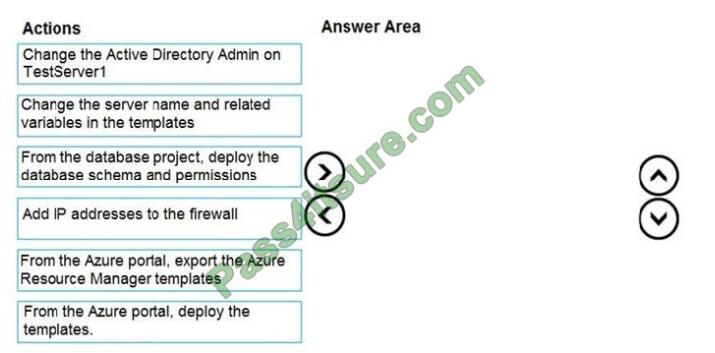
Correct Answer:
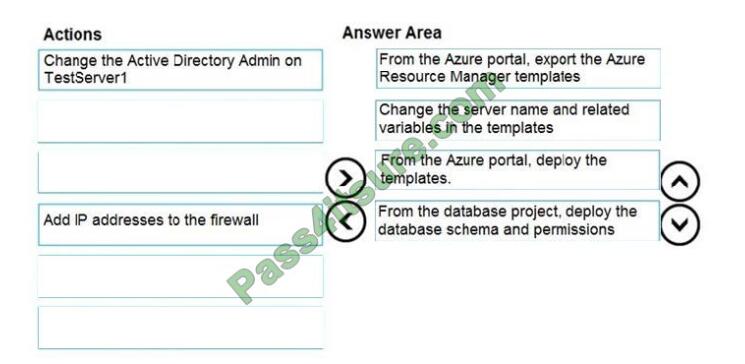
QUESTION 4
You are building a database backup solution for a SQL Server database hosted on an Azure virtual machine.
In the event of an Azure regional outage, you need to be able to restore the database backups. The solution must
minimize costs. Which type of storage accounts should you use for the backups?
A. locally-redundant storage (LRS)
B. read-access geo-redundant storage (RA-GRS)
C. zone-redundant storage (ZRS)
D. geo-redundant storage
Correct Answer: B
Geo-redundant storage (with GRS or GZRS) replicates your data to another physical location in the secondary region to
protect against regional outages. However, that data is available to be read only if the customer or Microsoft initiates a
failover from the primary to secondary region. When you enable read access to the secondary region, your data is
available to be read if the primary region becomes unavailable. For read access to the secondary region, enable readaccess geo-redundant storage (RA- GRS) or read-access geo-zone-redundant storage (RA-GZRS).
Incorrect Answers:
A: Locally redundant storage (LRS) copies your data synchronously three times within a single physical location in the
primary region. LRS is the least expensive replication option, but is not recommended for applications requiring high
availability.
C: Zone-redundant storage (ZRS) copies your data synchronously across three Azure availability zones in the primary
region.
D: Geo-redundant storage (with GRS or GZRS) replicates your data to another physical location in the secondary region
to protect against regional outages. However, that data is available to be read only if the customer or Microsoft initiates
a failover from the primary to secondary region.
Reference: https://docs.microsoft.com/en-us/azure/storage/common/storage-redundancy
QUESTION 5
DRAG DROP
You have SQL Server 2019 on an Azure virtual machine that contains an SSISDB database.
A recent failure causes the master database to be lost.
You discover that all Microsoft SQL Server integration Services (SSIS) packages fail to run on the virtual machine.
Which four actions should you perform in sequence to resolve the issue? To answer, move the appropriate actions from
the list of actions to the answer area and arrange them in the correct.
Select and Place:
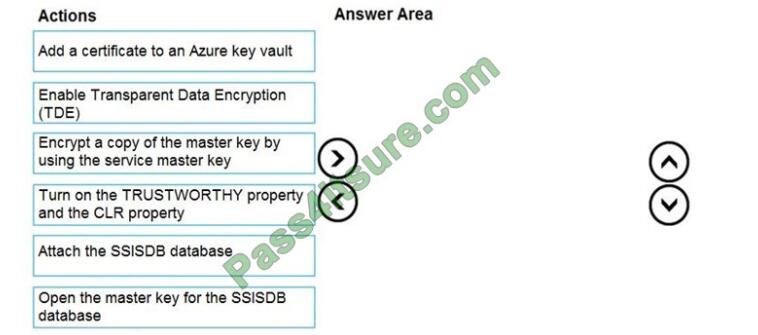
Correct Answer:
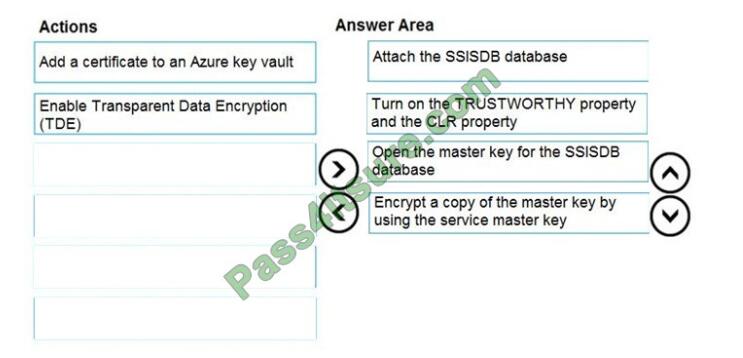
Step 1: Attach the SSISDB database
Step 2: Turn on the TRUSTWORTHY property and the CLR property
If you are restoring the SSISDB database to an SQL Server instance where the SSISDB catalog was never created,
enable common language runtime (clr)
Step 3: Open the master key for the SSISDB database
Restore the master key by this method if you have the original password that was used to create SSISDB.
open master key decryption by password = \\’LS1Setup!\\’ –\\’Password used when creating SSISDB\\’ Alter Master Key
Add encryption by Service Master Key
Step 4: Encrypt a copy of the mater key by using the service master key
Reference: https://docs.microsoft.com/en-us/sql/integration-services/backup-restore-and-move-the-ssis-catalog
QUESTION 6
HOTSPOT
You have SQL Server on an Azure virtual machine that contains a database named Db1.
You need to enable automatic tuning for Db1.
How should you complete the statements? To answer, select the appropriate answer in the answer area.
NOTE: Each correct selection is worth one point.
Hot Area:
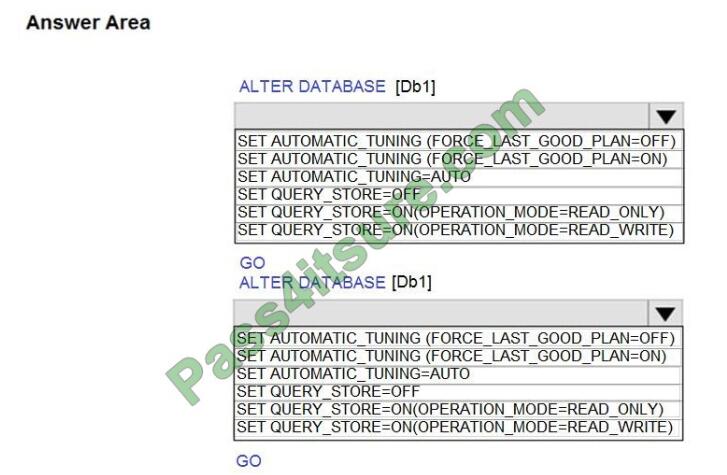
Correct Answer:
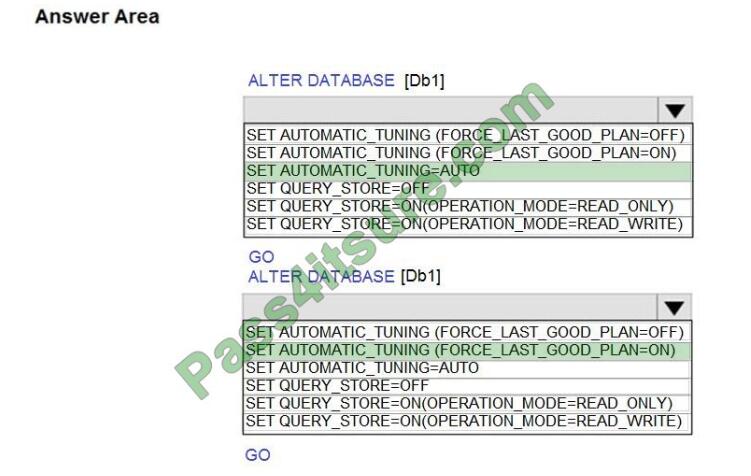
Box 1: SET AUTOMATIC_TUNING = AUTO
To enable automatic tuning on a single database via T-SQL, connect to the database and execute the following query:
ALTER DATABASE current SET AUTOMATIC_TUNING = AUTO
Setting automatic tuning to AUTO will apply Azure Defaults.
Box 2: SET AUTOMATIC_TUNING (FORCE_LAST_GOOD_PLAN = ON)
To configure individual automatic tuning options via T-SQL, connect to the database and execute the query such as this
one:
ALTER DATABASE current SET AUTOMATIC_TUNING (FORCE_LAST_GOOD_PLAN = ON)
Setting the individual tuning option to ON will override any setting that database inherited and enable the tuning option.
Setting it to OFF will also override any setting that database inherited and disable the tuning option.
Reference:
https://docs.microsoft.com/en-us/azure/azure-sql/database/automatic-tuning-enable
QUESTION 7
You are creating a new notebook in Azure Databricks that will support R as the primary language but will also support
Scala and SQL. Which switch should you use to switch between languages?
A. \\[]
B. %
C. \\[]
D. @
Correct Answer: B
You can override the default language by specifying the language magic command % at the beginning of a cell. The
supported magic commands are: %python, %r, %scala, and %sql.
Reference: https://docs.microsoft.com/en-us/azure/databricks/notebooks/notebooks-use
QUESTION 8
You have 50 Azure SQL databases.
You need to notify the database owner when the database settings, such as the database size and pricing tier, are
modified in Azure.
What should you do?
A. Create a diagnostic setting for the activity log that has the Security log enabled.
B. For the database, create a diagnostic setting that has the InstanceAndAppAdvanced metric enabled.
C. Create an alert rule that uses a Metric signal type.
D. Create an alert rule that uses an Activity Log signal type.
Correct Answer: D
Activity log events – An alert can trigger on every event, or, only when a certain number of events occur. Incorrect
Answers:
C: Metric values – The alert triggers when the value of a specified metric crosses a threshold you assign in either
direction. That is, it triggers both when the condition is first met and then afterwards when that condition is no longer
being met.
Reference: https://docs.microsoft.com/en-us/azure/azure-sql/database/alerts-insights-configure-portal
QUESTION 9
You are designing an anomaly detection solution for streaming data from an Azure IoT hub. The solution must meet the
following requirements:
1.
Send the output to an Azure Synapse.
2.
Identify spikes and dips in time series data.
3.
Minimize development and configuration effort. Which should you include in the solution?
A. Azure SQL Database
B. Azure Databricks
C. Azure Stream Analytics
Correct Answer: C
Anomalies can be identified by routing data via IoT Hub to a built-in ML model in Azure Stream Analytics
Reference: https://docs.microsoft.com/en-us/learn/modules/data-anomaly-detection-using-azure-iot-hub/
https://docs.microsoft.com/en-us/azure/stream-analytics/azure-synapse-analytics-output
QUESTION 10
You have 10 Azure virtual machines that have SQL Server installed.
You need to implement a backup strategy to ensure that you can restore specific databases to other SQL Server
instances. The solution must provide centralized management of the backups.
What should you include in the backup strategy?
A. Automated Backup in the SQL virtual machine settings
B. Azure Backup
C. Azure Site Recovery
D. SQL Server Agent jobs
Correct Answer: B
Azure Backup provides an Enterprise class backup capability for SQL Server on Azure VMs. All backups are stored and
managed in a Recovery Services vault. There are several advantages that this solution provides, especially for
Enterprises.
Reference: https://docs.microsoft.com/en-us/azure/azure-sql/virtual-machines/windows/backup-restore#azbackup
QUESTION 11
Note: This question is part of a series of questions that present the same scenario. Each question in the series contains
a unique solution that might meet the stated goals. Some question sets might have more than one correct solution,
while
others might not have a correct solution.
After you answer a question in this section, you will NOT be able to return to it. As a result, these questions will not
appear in the review screen.
You have an Azure Data Lake Storage account that contains a staging zone.
You need to design a daily process to ingest incremental data from the staging zone, transform the data by executing an
R script, and then insert the transformed data into a data warehouse in Azure Synapse Analytics.
Solution: You use an Azure Data Factory schedule trigger to execute a pipeline that executes mapping data flow, and
then inserts the data into the data warehouse.
Does this meet the goal?
A. Yes
B. No
Correct Answer: B
If you need to transform data in a way that is not supported by Data Factory, you can create a custom activity, not a
mapping flow,5 with your own data processing logic and use the activity in the pipeline. You can create a custom activity
to run R scripts on your HDInsight cluster with R installed.
Reference: https://docs.microsoft.com/en-US/azure/data-factory/transform-data
QUESTION 12
You have an Azure Synapse Analytics workspace named WS1 that contains an Apache Spark pool named Pool1.
You plan to create a database named DB1 in Pool1.
You need to ensure that when tables are created in DB1, the tables are available automatically as external tables to the
built-in serverless SQL pool.
Which format should you use for the tables in DB1?
A. JSON
B. CSV
C. Parquet
D. ORC
Correct Answer: C
Serverless SQL pool can automatically synchronize metadata from Apache Spark. A serverless SQL pool database will
be created for each database existing in serverless Apache Spark pools.
For each Spark external table based on Parquet and located in Azure Storage, an external table is created in a
serverless SQL pool database. As such, you can shut down your Spark pools and still query Spark external tables from
serverless SQL pool. Reference: https://docs.microsoft.com/en-us/azure/synapse-analytics/sql/develop-storage-files-spark-tables
QUESTION 13
DRAG DROP
You are creating a managed data warehouse solution on Microsoft Azure.
You must use PolyBase to retrieve data from Azure Blob storage that resides in parquet format and load the data into a
large table called FactSalesOrderDetails.
You need to configure Azure Synapse Analytics to receive the data.
Which four actions should you perform in sequence? To answer, move the appropriate actions from the list of actions to
the answer area and arrange them in the correct order.
Select and Place:
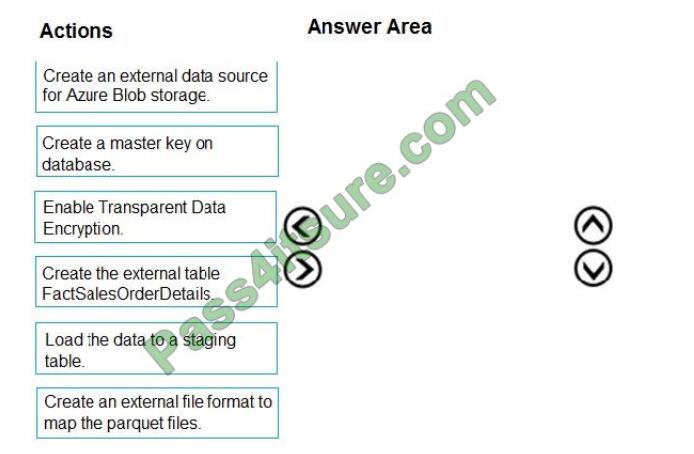
Correct Answer:
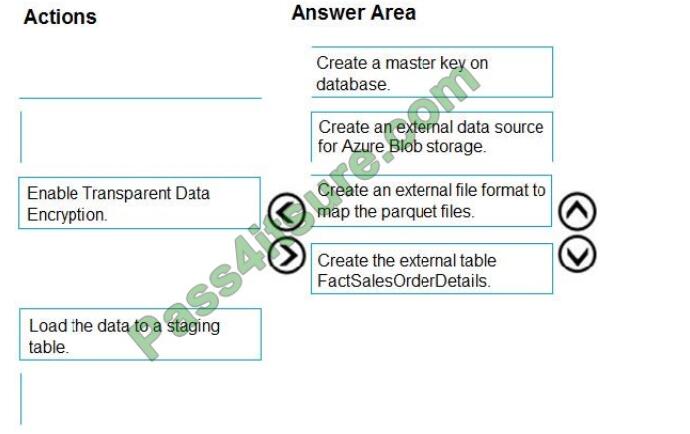
To query the data in your Hadoop data source, you must define an external table to use in Transact-SQL queries. The
following steps describe how to configure the external table. Step 1: Create a master key on database.
1.
Create a master key on the database. The master key is required to encrypt the credential secret.
(Create a database scoped credential for Azure blob storage.)
Step 2: Create an external data source for Azure Blob storage.
2.
Create an external data source with CREATE EXTERNAL DATA SOURCE..
Step 3: Create an external file format to map the parquet files.
3.
Create an external file format with CREATE EXTERNAL FILE FORMAT.
Step 4. Create an external table FactSalesOrderDetails
4.
Create an external table pointing to data stored in Azure storage with CREATE EXTERNAL TABLE.
Reference: https://docs.microsoft.com/en-us/sql/relational-databases/polybase/polybase-configure-azure-blob-storage
Role-based AZ-303 Exam Questions Free
https://www.work2you.org/simple-and-smart-way-to-pass-az-303-exam-latest-microsoft-az-303-practice-test-with-pdf-for-free/
Keep learning! The above are free test questions shared by Pass4itsure.
Latest Pass4itsure Microsoft Dumps Discount Code 2021
Pass4itsure Microsoft dumps discount code 2021 “Microsoft“. Enter the discount code to get a 15% discount!

One last word:
Your hard work and comprehensive Pass4itsure DP-300 exam dumps lead you to success. Click here to get complete DP-300 dumps https://www.pass4itsure.com/dp-300.html ( DP-300 PDF & Practice Test).